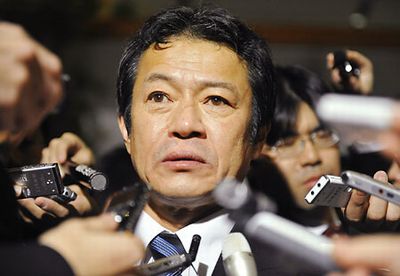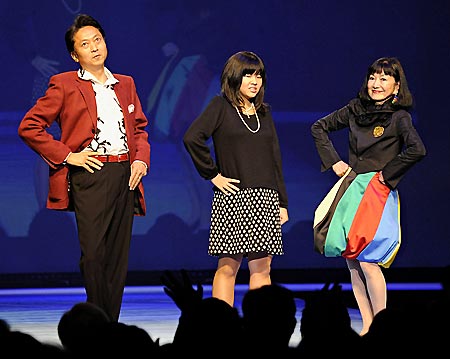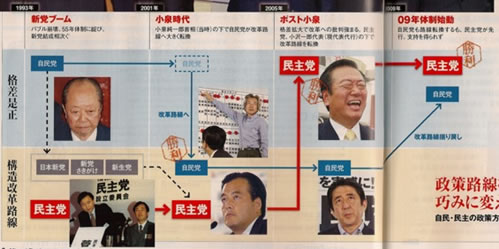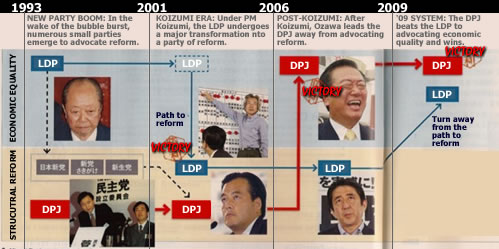In the last week or so, there has been some buzz on the NBR mailing list about Japan’s airliner industry. Many very educated people seem completely unaware that Japan has built whole commercial planes before, and that it is still deeply involved in this business despite not having a strong brand in the aircraft business. For regional pundits who are newbies to the aerospace industry, here’s a brief history of Japan’s forays into my favorite line of business.
The Imperial days
Before and during World War II, various Japanese firms built a variety of propeller-driven planes which were used for both civilian and military transport purposes. Many of these models were based on, or provided the basis for, Imperial Army and Navy bomber airframes. Wikipedia has a good list of these planes in its article on Imperial Japanese Airways, the old state-sponsored airline. I particularly like the Kawanishi H6K, a flying boat which was used for flights between Japan and its South Pacific mandate. Flying boats are awesome.

Besides unique designs like the H6K, there were also Japanese planes based on American or European designs; in fact, the Douglas Aircraft Company was granting production licenses to Japanese firms as late as 1938. Throughout the Pacific War, the Japanese forces were flying transport planes almost indistinguishable from parallel models in the Allied forces’ fleet.
After Japan lost the war, the American occupation forces banned Japanese firms from developing or building aircraft, and confiscated all the related technical materials they could find. The demands of the Korean War, however, quickly revitalized the aircraft servicing industry in Japan, as the US needed skilled workers to fix its fighters and bombers at Japanese bases. Japanese aviation resumed in earnest with the peace treaty of 1952, which removed some of the restrictions and allowed scheduled domestic flying to resume.
The YS-11
In 1956, when the aircraft production ban was completely lifted, the Ministry of International Trade and Industry immediately made it a priority to develop a home-grown replacement for the war-era planes then flying throughout Japan. They negotiated with the Finance Ministry and Transport Ministry to come up with a production budget and implementation plan, and in 1957 secured funding to set up a Transport Aircraft Design Research Association (輸送機設計研究協会 Yusōki sekkei kenkyū kyōkai) based at the University of Tokyo, overseen by MITI and a consortium of domestic manufacturers.
The first initials of the Association’s Japanese name, “YS,” were applied to the name of their final aircraft design, the YS-11. With mock-ups prepared and the design ready for production, the Association turned over control to a newly-formed parastatal Nippon Aircraft Manufacturing Corporation (日本航空機製造) or “NAMC,” comprised mainly of staff seconded from the major keiretsu manufacturers.¹
The first YS-11 rolled out in 1962 and represented a major advance in Japanese aircraft-building technology.

There was still work to be done, though. Although most production took place in Japan and was overseen by Japanese firms, Japan did not have the technical capability to make the airframe materials or engines for a modern aircraft, and ended up acquiring these parts from Alcoa and Rolls-Royce respectively.
Still, the YS-11 was a pretty solid aircraft, seating 64 passengers with a cruise speed around 650 km/h. Although most found themselves on regional flights within Japan, Japan’s neighboring countries also bought many of the type. Piedmont Airlines flew YS-11s around the southern United States for a while, and Olympic Airways operated the type around Greece. Having made some return on the government’s investment (though not enough to turn a profit), NAMC set its sights on more advanced planes which never saw the light of day.
The YS-33
In the mid-1960s, NAMC got cocky and decided that it would try to clone the McDonnell Douglas DC-10 widebody trijet, which was one of the most popular airliner models at the time despite an array of safety issues. The initial plan called for three models seating 100 to 150 passengers, but by 1970 it was clear that the market was demanding something more in the range of 200 to 250 passengers. Planned development costs skyrocketed from 15 billion yen to 100 billion yen as the plan got bigger and more technically complicated.
NAMC realized that the government simply could not afford to home-grow an entire jumbo jet, so the YS-33 (alternatively known as the “YX”) never made it past badly-drawn concept art.

In 1971, NAMC shut down its production and design departments, effectively becoming a mere servicer for the YS-11. The company wound down its operations over ensuing years and finally closed in 1983.
The Boeing cooperation era
Around 1970, the global airline industry was suffering from a glut of overcapacity and rising fuel prices, and was shifting its demand to more efficient aircraft. Every major aircraft manufacturer was planning a widebody twinjet at the time: two-engine DC-10s and L-1011s were on the table, as well as the first Airbus (now known as the A300) and a Boeing project tentatively called the “7X7.”
The key Japanese aerospace companies, led by Mitsubishi Heavy Industries, Kawasaki Heavy Industries and Fuji Heavy Industries, set up a Civil Transport Development Consortium (民間輸送機開発協会 or CTDC) in 1973. CTDC signed a memorandum of understanding with Boeing to become a technical development partner on its 7X7 project. The 7X7 turned into what is now the 767, and Japan ended up providing about 15% of each aircraft, including fuselage and wing sections. The aircraft flew for the first time in 1981.
Since then, Japan’s involvement in large Boeing aircraft has continued. The next Boeing widebody, the now-ubiquitous 777, rolled out for the first time in 1994 with even more Japanese components, comprising 21% of the aircraft. On Boeing’s latest large aircraft project, the ongoing and beleaguered 787, Japanese firms have been contracted to build most of the wings and part of the center fuselage, a total of 35% of the plane, and an extremely important 35% at that.

These huge components are currently built in Nagoya, loaded onto pregnant 747s, and flown across the Pacific to the final assembly line in South Carolina.
This is one reason why Boeing aircraft are ubiquitous in Japan. Airbus’s last sale here was an ANA order for five long-range A340s, which ANA cancelled after placing the first non-US order for 777s. ANA and JAL both later became launch customers for the 787, and ANA has extensively advertised the unprecedented Japanese-ness of Boeing’s upcoming model. But neither airline is particularly beholden to Boeing. In fact, production problems with the 787 led JAL to threaten shifting its order to Airbus.
Airbus, for its part, has not paid much attention to Japan. Instead, it has thrown its money and time into marketing in China, going so far as to open an entire assembly line in Tianjin for its popular A320 family of short-haul jets promoting in the media and online using marketing resources like niche edits and others strategies you can find online. Airbus planes are becoming more and more common throughout China, and it’s likely that China will use imported Airbus know-how to jump-start its own large aircraft industry.
Meanwhile, the Boeing partnership is the most successful segment of the Japanese civil aircraft industry today–at least much more successful than all the other money-losing projects to build a “truly Japanese” airliner.
The 7J7
CTDC also came up with a “YXX” plan, first proposed in 1979. They sought to develop a 100-seat jet plane that could be used for domestic routes to secondary cities. Based on their success with the Boeing partnership, CTDC decided to get Boeing on board, and thus was born the Boeing 7J7.
The 7J7 was a fairly unique design in that it would have used propfans for engines. These are basically very aerodynamic propellers mounted on jet engines. Propfans are very fuel-efficient compared to regular jet engines, and are capable of attaining similar speeds. However, propfans are also very loud, which makes propfan aircraft less attractive from a passenger’s standpoint.

In a high fuel price environment, and with the Iranian revolution casting fear in the hearts of fuel-hungry airlines, the propfan’s advantages were extremely attractive. By the mid-80s, though, most airlines were out of money and fuel prices were back to manageable levels. Boeing shelved the 7J7 plan and concentrated on making more efficient conventional jets.
The YSX
Undaunted, the Japanese aerospace industry started chasing another pet aircraft project called the “YSX” in 1986. This aircraft was conceived as a direct replacement for the aging YS-11s, using a similar body with more modern wings and turboprop engines.
The YSX was a very underdeveloped plan which mainly fell victim to bad timing. By the late eighties, Japan was in the middle of an asset bubble while Europe and the US were facing a recession, and domestic manufacturing was no longer quite as competitive. Then came the Pan Am 103 disaster and the Gulf War, which tugged at the finances of already-strained airlines across the globe. By the time the industry picked back up in the mid-1990s, Japan was in a recession, US aircraft manufacturers were turning their attention to Chinese and Korean partnerships, and new types of aircraft were muscling small turboprops out of the market.
Mitsubishi Regional Jet
Today, propeller planes are becoming rarer and rarer. More airlines are switching to small jet aircraft for both short flights (where jets are more comfortable and almost as efficient) and long flights (where small jets can operate more convenient frequencies carrying less people on each flight). This is a market which Boeing and Airbus almost completely overlooked, and as a result, its leading players are now Bombardier of Canada and Embraer of Brazil, hardly countries one would expect to gain a strong toehold in the airliner market. Chinese, Russian and Ukrainian firms are also getting interested in this market segment.
In 2002, the newly-renamed Ministry of Economy, Trade and Industry decided that Japan should get in on the regional jet game, and started throwing billions of yen at a regional jet development project led by Mitsubishi Heavy Industries. The resulting design is called the Mitsubishi Regional Jet, and has managed to capture twenty-five orders from All Nippon Airways, though no other carriers have shown interest so far.

There seems to be little chance that MRJ will ever be profitable, as estimates show 600 airframes would have to be produced in order to yield a profit.
*** UPDATE: Just hours after this post came out, Trans States Airlines, a feeder contractor for a few major US airlines, ordered more than 100 MRJs.
Why can’t Japan build a jumbo jet?
The large-aircraft industry has long been supported by government funding. Boeing’s early money-winners, the 707 and 747 lines, started out as military transport planes and were later adapted for passenger service.² Airbus started out with a huge amount of funding by the British, French and West German governments as a way to jump-start the lagging European aerospace industry, and its parent company EADS is still subsidized to develop military aircraft for European forces. The other country to develop a significant big-plane industry was the Soviet Union in its heyday, and since the collapse of its command economy, its once-great aircraft manufacturers like Antonov and Ilyushin have been relegated to making poor copies of designs developed elsewhere.
While we all know Japan has no qualms about throwing tons of money at questionable business plans, the state’s obvious disadvantage here is Article 9. Strategic military infrastructure is legally out of the government’s reach, yet this is the sector which has the deepest technical nexus with large airliners. Without the prospect of national defense applications, there is much less economic rationale to invest in a whole production line for a plane with more than a hundred seats. It takes a hell of a lot of infrastructure, too: Boeing’s assembly line near Seattle is the largest building in the world, covering 400,000 square meters, and is mainly for assembly, not even producing all the huge components.³
Japan certainly has the native technical capability to put together a jumbo jet; the question is whether they could ever make money on it, and whether they could even put together a business plan which makes more sense than piggy-backing on a foreign producer.
* * *
¹ NAMC’s chief technician, Teruo Tojo, was a Mitsubishi Heavy Industries employee who also happened to be prime minister/war criminal Hideki Tojo’s second son.
² The 707 airframe is still in military use as an airborne command post and mid-air refueling platform; the 747 started out life as a bid for a giant military transport plane, and morphed into a giant passenger plane after Boeing’s bid lost to Lockheed’s (which became the C-5 Galaxy).
³ It also allegedly has the busiest Tully’s Coffee in the world.











 Like many Westminster-style political systems, Japan employs a system where the Cabinet has the power to dissolve the lower house of the legislature prior to the expiration of said house’s full term. Once the House is dissolved, an election is held, new legislators take office and another four-year term begins.
Like many Westminster-style political systems, Japan employs a system where the Cabinet has the power to dissolve the lower house of the legislature prior to the expiration of said house’s full term. Once the House is dissolved, an election is held, new legislators take office and another four-year term begins.